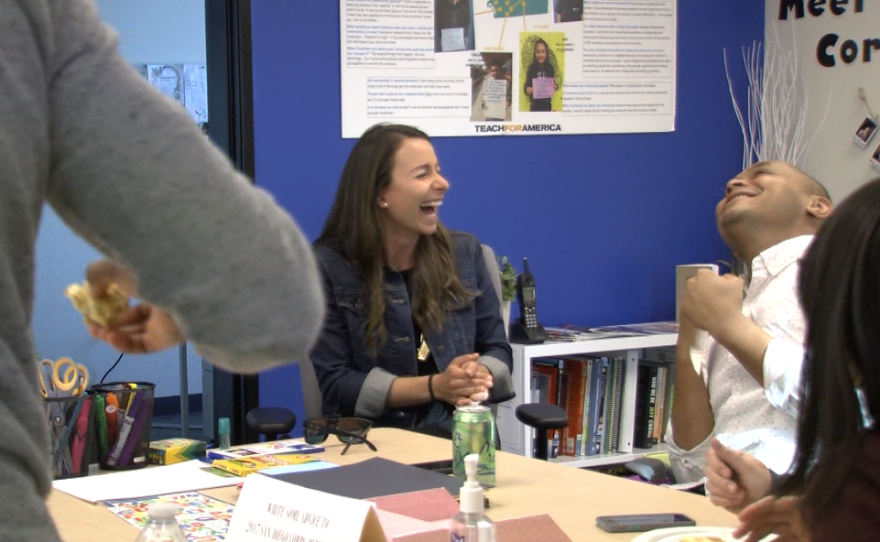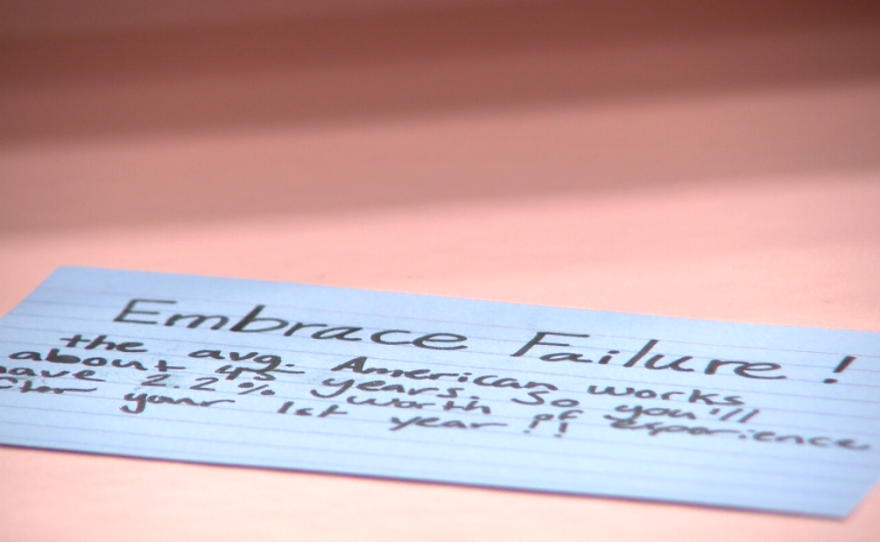Those pink slips landing in teacher mailboxes right now — they are one of the reasons the number of teaching credentials awarded by San Diego universities dropped 30 percent between 2010 and 2015. The profession can look pretty unstable for college students taking on debt.
And that is a problem, because California needs more teachers. The state projects it will need more than 20,000 new teachers annually. Statewide, universities have been graduating about half that, according to the Learning Policy Institute.
KPBS has been looking at what the state and schools can do to encourage more people to become teachers. Here is what we have learned.
The Obvious One: Money
Beginning teachers in San Diego County make between $37,000 and $48,000. That is about than $20,000 below the median income here and can make it pretty difficult to afford a home.
Take Elijah Gonzalez, a special education teacher at Thrive Public School in Rolando whom we have been checking in with throughout the year. He is wrapping up his first year of teaching and thinking about the future.
"I love Thrive, I love the environment, I believe in the mission," Gonzalez said. "But if I want to stay in California and continue living in California, I have to look at my budget."
RELATED: San Diego Teachers: What Makes Them Stay?
Gonzalez is also wrapping up a short-lived house hunt. There is a special program that will pay up to $15,000 toward a down payment for teachers, but the Chicago transplant said his student debt and income have kept him from qualifying for a loan to buy in the San Diego market. He said that would not have been the case back in Chicago.
"If we wanted a basic townhouse here, you'd probably spend around $230,000 to $275,000. In Chicago there's places that are that expensive and more, but there's also more affordable option," Gonzalez said. "One of my coworkers here, she's also from Chicago, and she got a condo for $80,000. There's nothing on the market for $80,000 here. Even trailers are going for like $120,000. It's expensive."
Currently, California lawmakers are considering several options to help new teachers. One proposal being heard by the Assembly Appropriations Committee Friday would set aside $100 million to help school districts build housing for their teachers. Assemblyman Tony Thurmond, D-Richmond, put forward the bill amid cries from Bay Area teachers who could not afford to live in the region. San Francisco this month approved $44 million to build teacher housing.
Another bill headed to the Senate Appropriations Committee this week would cut teachers' income tax in half and give them tax credits to cover the cost of their credentials. Similar to a federal loan forgiveness program for teachers, those benefits would kick in after five years of teaching.
But many say that timeline is a problem. Five years can be a long time to wait under crushing bills and a tight rental market. That is why universities and other stakeholders are looking for ways to reduce the cost of credentialing.
San Diego State University and other California State University campuses are developing programs that let would-be teachers earn their credentials in tandem with their bachelor's degree. That means one less year of school to pay for.
And universities, school districts and charter school operators are increasingly embracing residencies. Those let individuals teach with provisional credentials so they can earn money while completing their full credentials in the evenings.
RELATED: More And More Teachers Aren’t Fully Trained — And That Could Be A Good Thing
But a lot of people who spoke with KPBS said, while a good start, such measures are more like Band-Aids. The real answer, they said, is to better fund education.
"I love what I do, but it sure would be nice if the salaries that teachers earned mirrored the values that we have around education," said Nicole Assisi, director of Thrive Public Schools.
This year, EdWeek ranked California 46th out of 50 for what it spends on students. With the cost of living taken into account, the state spent $8,694 per student in 2013. That is nearly $3,500 less than the national average.
In San Diego County, spending ranged from $14,874 in the Rancho Santa Fe Elementary School District to $683 in the Spencer Valley Elementary School District in Santa Ysabel. The majority of districts spent between $8,000 and $10,000, with the county's largest, San Diego Unified, spending $9,880.
State finances have improved since 2013, the year on which the current rankings are based. Gov. Jerry Brown this year has proposed a 5.4 percent increase in education funding for next year.
Meanwhile, the federal government, which spends about 3 percent of its budget on education, is proposing significant cuts to the Department of Education.
The Big One: Workplace Quality

David Lopez heads Teach for America San Diego, which is trying to recruit more teachers for San Diego area schools. He remembers his first year teaching bilingual kindergarten.
"Sometimes I'd get to the end of the week, and I would just go crash in my bed on a Friday afternoon and not wake up until the next morning at like 9:00 or 10:00 a.m.," he said. "I don't think I expected that teaching would take that much emotional and physical energy."
What got him through it was a supportive principal.
"(He) basically said, 'I believe in you. I see you really care about your work. I love the energy you bring to the classroom. I believe in you, and we're going to be there with you as you figure out some of the more technical details around lesson planning and lesson delivery and assessment,'" Lopez said. "And that meant a ton for me."
Like Lopez, current and former teachers consistently say a supportive work environment is key in keeping teachers around.
Those who left the profession told the National Center for Education Statistics that workplace conditions and management practices were as important, if not more, in influencing their decision to leave as did pay and benefits. These included being dissatisfied with the administration at their school, a lack of autonomy, a lack of influence in school policies and practices, and not enough professional advancement.
To be sure, the root of some of these problems is also money. Budget woes lead to fewer support staff, exacerbating the do-it-all nature of teaching. And giving teachers time outside of the classroom for professional development can cost a school as much as hiring a new teacher.
"As I think about a school principal trying to provide art classes, as well as physical education, as well as all the core classes like math, science, reading, writing — all of those are choices that are being made on a daily, weekly, yearly basis," Lopez said. "And the resources are never enough to be able to cover the needs."
But Lopez said there are some things that strong school leaders can do for the cost of a pizza that improve teacher retention.
On a recent evening, he brought together current and former teachers for pizza and bonding over classroom horror stories and tales of their first year on the job. A sign on the table urged attendees to leave advice for new teachers.
"Embrace failure," one of the cards read. "The average American works about 45 years, so you'll have 2.2 percent worth of experience after your first year."
Lopez, and many others who spoke with KPBS, said teachers can feel isolated pretty easily. Providing opportunities for staff to interact and plan lessons together can counteract that. It is especially important for new teachers; those without mentors at their school are twice as likely to leave the profession than those who do, according to the Learning Policy Institute.

School and district leaders can also take steps to make decision-making more democratic. Education is a big, sometimes unwieldy operation that can trample the people in the trenches.
"There are decisions that administrators need to make and are tough to make," said Carlos Turner Cortez, president of San Diego Continuing Education. "But I would say about 75 to 80 percent of the decisions I'm expected to make should include input from stakeholders."
Cortez previously was director of a Los Angeles charter school for pregnant and parenting teens. He said he established faculty, parent and student councils there, each with voting rights on campus decisions. He said the process led to a more harmonious campus and even learning opportunities — like when the students wanted new uniforms.
Cortez said the girls, some who had multiple pregnancies, were not comfortable in their one-size-fits-all uniforms. So the school's fashion illustration class designed and pitched new uniform options. They went from pleated khakis and blue shirts to pink and black trousers, sweat pants and various shirt options.
The councils had similar say on course offerings.
"The reality is that in most educational institutions, especially underserved ones, administrators have a very short shelf life. The average tenure for a high school principal in an urban area is less than a couple of years," Cortez said. "So it is my belief that effective administrators don't come into an institution with the expectation of transforming that institution in their vision but rather lead faculty and staff through planning efforts toward creating and establishing a shared vision."
While school leadership can make or break a teacher's experience, Thrive Director Assisi said it is up to everyone to figure out how to solve California's teacher shortage.
"I think the primary responsibility lies on a supervisor to make sure the people they supervise are trained and growing," Assisi said. "That being said, education isn't just a 9-to-5 job, right? We are responsible for supporting the next doctors, lawyers and legislators in becoming who they are. So I think the more minds the better to help teachers be the best they can be."






